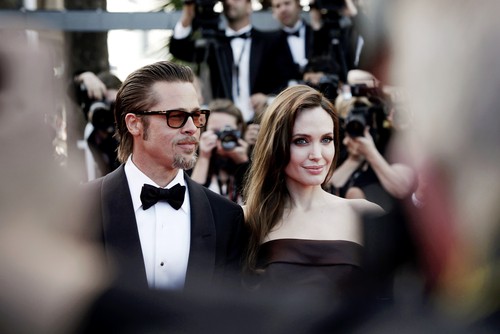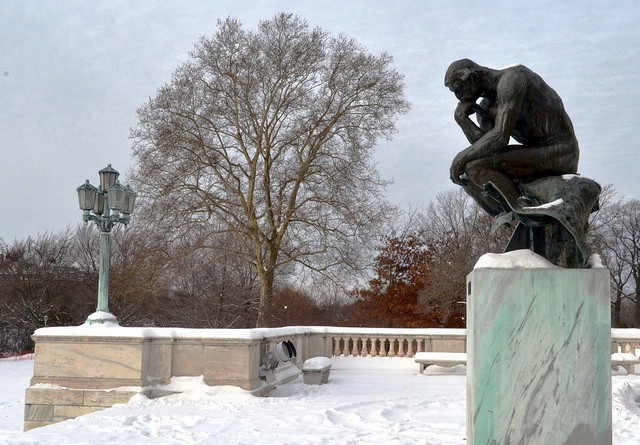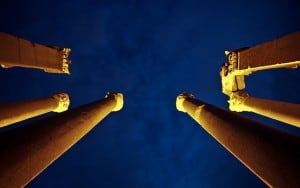You have probably never heard of me. I mean, that’s okay; I’m fine with it. Really, I am. After all, my fifteen minutes of televised fame came early in life.
Now, it wasn’t exactly fifteen minutes, precisely; it was 30 seconds. And it was a 30-second commercial, of which I was only visible for about five. Yet, to my eight year-old self, five seconds of fame felt like forever. The commercial was a promo for one of Cleveland’s local television channels. You know, the ones where they go “we know OUR city,” and then have a montage of B-reel shots of Cleveland’s two famous landmarks before cutting to footage of the evening news team walking in and crossing their arms as they turn and face the camera, like a group of well-heeled superheroes.
My fame — such as it was — began one afternoon when a handful of grade school classmates and I were carted off to the Cleveland Museum of Art for our contribution to the B-reel. When all the cutting was done, for three whole seconds you could see the side of my face as I stared, eyes rapt in wonder, as the guide pointed out features of the full-sized knight and his horse in the Armor Court of the museum. Then you got at least a good two seconds of me and my classmates in our Catholic school uniforms running up the steps toward Rodin’s The Thinker perched on a pedestal on the front steps. The commercial ran every day for the next six weeks. For six glorious weeks, I was a celebrity.
My fifteen minutes of fame, sadly, did not leave any lasting impressions, not even within my family. I talked to my mom on the phone the other day and told her about this article. “Really, what commercial?” she asked, “I don’t remember that at all.” Wow. Best mom ever.
***
Fame, like so much in life, is fleeting. Walker Percy, in his essay “The Loss of the Creature,” says that tourists take pictures of the Grand Canyon not to prove that they were there, but to prove that it was — that the Grand Canyon even exists. Perhaps it is the same with celebrities; we are drawn to see them to prove that such beautiful, charming people do, in fact, exist off screen. As we march through awards season and head into the Oscars, celebrities pop up in newsfeeds more than ever. I wonder if it isn’t because we the non-famous need some hard evidence that some sub-genus of homo sapiens could have evolved to actually be that attractive, that smart, and that cool, all in the same body. I mean, I am certainly not like that, and I don’t really know anybody who is — not even the local news anchors in Cleveland.
This desire to prove that these kinds of people exist has been around for a long time. There is a strange bit of history that comes to us from the deserts of Egypt in the late fourth century: thousands of people left their urban homes and flocked to the desert. It got so bad that St. Athanasius declared, “the desert had become a city.” People were drawn out to the wilds to verify the existence of the most intriguing celebrities of their time, the so-called Desert Fathers and Mothers whose fame spread across the empire because of their mastery of the ascetical life.
Take St. Simeon Stylites. He once climbed atop a column to get away from the trappings of urban life. As it goes with desert eccentrics of this sort, he lived the rest of his days atop that tall pillar, content to have nothing more than a small, one square meter platform in the middle of the desert. And as it goes with people hungry to observe such eccentrics, thousands of people journeyed out into the desert to see Simeon, content, atop his pillar — over the course of 37 years. They went for all kinds of reasons, from pious admiration to just plain voyeurism. No doubt that seeing such unusual celebrity had an effect on people; though it may not have been an immediate one. At some point afterward, maybe something struck them as they journeyed home — walking, in a straight line, thousands of times farther than Simeon could on his platform. Or maybe as they entered their house and had a roof over their head, maybe when they kissed their kids goodnight, or finally crawled into bed after the dishes…something clicked and they finally got it. For just a moment, maybe they felt alive and blessed in a deeper way, and utterly grateful. They found food in the cupboard, the lamp on the stand, and the warm body lying next to them. They saw these simple trappings in a whole new light, all because of Simeon, who had chosen — willingly — to give those normal things up. Maybe it was then, and only then, that they realized how full their lives were. Full of the good and the bad; full of goods, but also lacking and longing for some higher Good. They went to see Simeon, but ended up finding themselves.
***
I think that Percy only got it half right. We take a picture of the Grand Canyon, or a celebrity, not only to prove that they exist, but that we exist.
The crazy thing about these unconventional saints, these Fools-for-Christ as they were called (and still are, because they exist today), is not that they can live with so little food or shelter or rest; the really crazy thing is that evidently (it seems) we cannot do what they do, and yet we’re drawn to it. What is crazy is not that they exist but that we do. And great beauty, whether in the curves of the Grand Canyon or the curves of a celebrity, serves to remind us that we are truly alive, able to take in all that beauty outpours. That beauty exists is not so great a miracle as that we exist to be moved and touched profoundly by it.
Celebrities today show us what natural beauty looks like, it is true. But the Desert Fathers and Mothers had their own attraction too, a kind of harsh beauty encountered only at the limits of the familiar, a beauty that terrifies even as it enthrals. It is a kind of jarring beauty that comes to me on warm summer nights, as I lie in the grass watching the stars come out one, then two, then cover the night sky like salt; I realize how small I am, and how big the universe is. All that exists…and so do I. It is a mesmerizing beauty that drew people to deserts in the fourth century even as it draws some to the top of Mt. Everest today. And it was Beauty that drew Simeon to find joy, and life, and purpose, atop his one square meter of this universe.
***
Just as celebrities today can leave us feeling insecure and overweight and mundane, the Desert Fathers and Mothers can leave us feeling lazy in prayer, tepid in our resolve to resist temptation, and terrified of fasting. I will no sooner look like Brad Pitt than I will fast for 37 years. Anyone who ever saw a red-and-purple sunset over a crystal lake, or a dancer effortlessly arch her body in perfect rhythm to music, knows that great beauty can leaves us acutely aware of our limitations. At worst, we compare the beauty we see with the internal feelings and limitations we know all too well. But the effect of finding beauty at the limits doesn’t have to end in limitation. Our encounter with the beautiful, like the holy, can broaden our heart and mind to imagine the possibilities for ourselves. I may not endure like the Grand Canyon or ever look like George Clooney, but I have experienced great beauty that lead me to consider its Source.
Celebrities, secular and sacred, can point to where we fall short; or they can force us to look at ourselves to ask, What do I value? What do I search for in life, and where have I gone down dead ends? And if you’re like me — two decades after my forgotten commercial fame — they might even show the limits of pursuing celebrity in the first place.
I guess I am not really a celebrity, and that is okay. I guess my mom may be right. (She usually is). “Oh, honey,” I hear her saying at the end of our chat, “you’ll always be famous to me.” Thanks, mom. Best mom ever.




